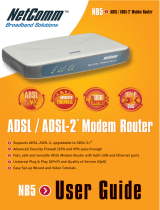Quick Install Guide
Quick Install Guide Page 2 of 27
Table of Contents
Preliminary Pages Page
Table of Contents...................................................................................................................2
Chapter 1 – Introduction......................................................................................................5
1.1 Minimum Requirements...................................................................5
1.2 AT-AR236E Package.......................................................................6
1.3 AT-AR236E Overview.....................................................................7
1.3.1 Front Indicators ................................................................................7
1.3.2 Back Panel........................................................................................8
1.4 Typical AT-AR236E Connection.....................................................9
Chapter 2 – Connecting the AT-AR236E to Your Computer/Notebook...........................10
2.1 Connecting to the Ethernet.............................................................10
2.2 Connecting to the ADSL................................................................11
2.3 Checking Your Connections...........................................................12
2.4 Connecting the USB Cable.............................................................12
2.5 Connecting the Power Adapter.......................................................13
2.6 Powering On...................................................................................13
Chapter 3 – Configuring Your Ethernet Network Card.....................................................14
3.1 Configuring Your Ethernet Network card......................................14
3.1.1 For Windows
®
98 Second Edition / Windows
®
Me.....................14
3.1.2 For Windows
®
2000 / Windows
®
XP...........................................15
Chapter 4 – Installing Your USB Driver ...........................................................................17
4.1 Installing the USB Driver for Windows
®
98 Second Edition ........17
4.2 Installing the USB Driver for Windows
®
Me.................................18
4.3 Installing the USB Driver for Windows
®
2000..............................19
4.4 Installing the USB Driver for Windows
®
XP.................................20
Chapter 5 – Configuring Your Web Browser....................................................................22
5.1 Microsoft® Internet Explorer™ (based on IE 5.5) ........................22
5.2 Netscape Navigator ........................................................................22
Chapter 6 – Setup AT-AR236E via Quick Start................................................................23
Chapter 7 – Maintenance ...................................................................................................26
7.1 Maintenance Concepts....................................................................26
7.2 Preventive Maintenance .................................................................26




















